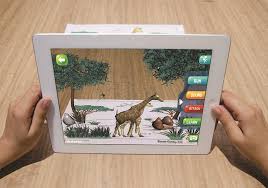In today’s modern classrooms, educators are constantly looking for new ways to make learning more accessible and engaging in Augmented Reality— especially when it comes to complex subjects like science, math, engineering, and medicine .
One of the most powerful tools emerging in this effort is(AR) — a technology that overlays digital content onto the real world, helping students visualize and interact with abstract or difficult-to-grasp ideas.
In this article, we’ll explore how augmented reality simplifies complex concepts , why it works so well in education, and what tools you can start using today to transform your teaching approach.

What Is Augmented Reality?
Before diving into its educational impact, let’s define what Augmented Reality (AR) really means.
AR enhances the real world by overlaying digital content — such as images, videos, or 3D models — onto a user’s environment using devices like smartphones, tablets, or AR glasses. Unlike Virtual Reality (VR), which creates an entirely artificial environment, AR blends digital elements with the physical world, making it ideal for classroom use.
This makes AR especially valuable in education — where abstract concepts can be made tangible, and passive learning can become active exploration.
Why Students Struggle with Complex Concepts
Traditional teaching methods often fall short when it comes to explaining complex topics. Many students struggle because:
- 📉 They learn passively through lectures and textbooks
- 🧠 Abstract ideas are hard to visualize
- 💡 Lack of interactivity leads to disengagement
- 🎯 One-size-fits-all instruction doesn’t suit diverse learners
Subjects like anatomy, physics, chemistry, and advanced mathematics often suffer from these issues — leading to frustration, poor performance, and even loss of interest.
That’s where AR steps in.
How AR Makes Learning Easier
Here are some key ways AR helps simplify complex ideas:
1. Visualizing Abstract Concepts
Many academic topics — like molecular structures, planetary motion, or cellular biology — are difficult to grasp through text or static images alone. AR allows students to interact with 3D visualizations of molecules, planets, ecosystems, and more — helping them understand spatial relationships and processes in a meaningful way.
For example:
- In biology, instead of memorizing diagrams of cells, students can explore each layer in real time.
- In astronomy, they can rotate planets and zoom into moons — all from their classroom floor.
2. Interactive Models and Simulations
AR brings lessons to life by allowing students to manipulate digital objects and observe changes in real time.
This kind of interaction transforms passive learning into active discovery — increasing understanding and long-term retention.
Some examples include:
- Exploring the human heart in 3D
- Performing virtual dissections safely
- Simulating chemical reactions without safety risks
These simulations allow students to experiment freely, test hypotheses, and see results instantly — something traditional methods simply cannot match.
3. Gamification of Learning
Many AR apps incorporate game-like features such as points, badges, challenges, and leaderboards. These elements encourage friendly competition and keep students motivated.
Gamified AR lessons increase attention span and participation — especially among younger learners who are used to interactive media.
4. Real-Time Feedback and Assessment
Some AR platforms offer instant feedback during experiments, helping students identify mistakes and improve faster.
In math or language learning apps, for instance, students can solve problems and receive real-time corrections — reinforcing learning and building confidence.
5. Encourages Self-Directed Exploration
With AR, students aren’t just following instructions — they’re exploring, experimenting, and discovering answers on their own.
This fosters curiosity and deeper understanding — especially for those who may not thrive under traditional instruction methods.
Benefits of Using AR in Education
Let’s break down some of the most impactful benefits AR brings to the table:
| Benefit | Description |
|---|---|
| 🧠 Enhanced Visualization | Abstract ideas become tangible through 3D models and interactive visuals. |
| 🎯 Better Student Motivation | Gamified AR lessons increase attention span and participation. |
| 🧑🏫 Inclusive Learning | Supports diverse learning needs, including special education and language learners. |
| 💻 Cost-Effective Tools | Reduces reliance on expensive equipment and lab setups. |
| 📱 Scalability | Works across subjects, age groups, and learning environments. |
These benefits suggest that AR has the potential not only to enhance current education systems but also to revolutionize them.
Top AR Tools That Help Students Understand Hard Topics
Here are some of the best AR platforms currently transforming how students learn complex subjects:
| Tool | Best For | Key Features |
|---|---|---|
| Merge Cube | STEM Education | 3D object manipulation, tactile learning |
| zSpace | Advanced STEM | Hybrid AR/VR platform for in-depth exploration |
| Elements 4D | Chemistry | Simulate chemical reactions safely |
| Anatomy 4D | Biology | Explore human body systems in detail |
| Adobe Aero | Custom Content Creation | Create personalized AR lessons without coding |
| HP Reveal (formerly Aurasma) | Textbook Enhancement | Turn static pages into interactive AR experiences |
| CoSpaces Edu | Coding & Creativity | Build AR worlds and stories; supports Blockly and JavaScript |
| SkyView® Explore the Universe | Astronomy | Identify stars, planets, and satellites in real time |
Most of these tools are easy to use, compatible with common devices, and many offer free versions — making them accessible for most schools.
Real-World Examples of AR in Action
Let’s look at a few real-life examples of how AR is being used to unlock interactive learning:
🔬 Science Class: Virtual Dissections
Instead of using actual frogs, biology students can perform dissections in AR. This eliminates ethical concerns, reduces costs, and allows multiple attempts — increasing both engagement and understanding.
🗺️ History Class: Time Travel Through AR
Students can “stand” beside historical figures, walk through ancient civilizations, or witness key events unfold before their eyes — all from the safety of the classroom.
📐 Math Class: Geometry in 3D
Geometry becomes more engaging when students can manipulate 3D shapes and visualize formulas in action. AR apps allow them to rotate, zoom, and interact with geometric figures like never before.
These examples show that AR isn’t just a futuristic idea — it’s being applied right now to make learning more engaging, inclusive, and effective.
How Teachers Can Use AR Effectively
You don’t need to be tech-savvy to begin integrating AR into your teaching. Here’s how to get started:
Step 1: Define Your Learning Goals
Identify what you want students to learn. Choose AR tools that align with those objectives.
Step 2: Start Small
Begin with one or two apps that match your subject area and class needs. Many offer free trials or limited versions.
Step 3: Train Yourself
Use tutorials and demo videos to become familiar with the app before introducing it to students.
Step 4: Integrate Into Lessons
Find ways to incorporate AR naturally into your existing curriculum. For example:
- In English, animate story settings.
- In geography, explore topographical maps.
- In social studies, simulate ancient trade routes.
Step 5: Gather Feedback
Ask students how they felt about using AR. This will help you refine future lessons and choose better tools.
Case Studies: AR in Real Classrooms
Let’s take a closer look at how AR is being used successfully in education:
🏫 New York City Schools
Several NYC schools have adopted AR-powered anatomy apps that allow students to explore the human body layer by layer. This interactive approach has led to improved test scores and increased interest in medical fields.
🌐 Online Learning Platforms
Platforms like Coursera and Udemy now integrate AR modules in courses related to engineering, design, and architecture — allowing remote learners to manipulate 3D models as part of their coursework.
🧪 University Medical Programs
Some universities use AR to simulate surgery procedures, giving medical students a safe, repeatable way to practice techniques before entering the operating room.
These case studies highlight how AR is already changing the way students learn — and how it can be applied to complex subjects worldwide.
Benefits Across Age Groups
AR is effective across all levels of education:
| Grade Level | AR Application |
|---|---|
| Elementary | Interactive storytelling, basic science |
| Middle School | Virtual labs, history reenactments |
| High School | Anatomy, chemistry, physics simulations |
| Higher Ed | Medical training, engineering design, language immersion |
Each level benefits differently, but the underlying principle remains the same: learning through doing .
Challenges & Solutions
While AR offers many benefits, there are still some hurdles to overcome:
💸 High Costs of Hardware
Some advanced AR tools require special headsets or devices.
Solution: Start with free apps that work on existing devices like smartphones and tablets.
🛠️ Technical Limitations
Not all schools have the infrastructure to support high-quality AR applications.
Solution: Advocate for grants or funding for EdTech initiatives.
📚 Teacher Training
Educators may feel overwhelmed by new technology.
Solution: Provide professional development workshops and peer mentoring.
The Future of AR in Education
As AR technology continues to evolve, we can expect even more innovative applications in education:
👓 Wearable AR Devices
Lightweight AR glasses will replace tablets and smartphones in classrooms, allowing hands-free interaction with digital content.
☁️ Cloud-Based AR Learning
Cloud computing will enable seamless, real-time access to AR content without requiring powerful local devices.
🤖 AI Integration
AI-powered tutors embedded in AR environments will offer real-time guidance, adapting lessons to each student’s progress.
🌐 Global Collaborative Learning
Students from different countries will join the same AR environment to collaborate on projects, breaking down geographical barriers.
Final Thoughts: Embrace AR in Your Classroom
The rise of augmented reality in education is not just a trend — it’s a transformation in how we teach and learn. From elementary classrooms to university lecture halls, AR is helping students visualize complex topics, stay engaged, and take ownership of their learning journey.
If you’re an educator ready to embrace innovation, there’s never been a better time to explore AR. With the right tools and strategies, you can turn your classroom into a dynamic, interactive learning hub where every lesson comes to life.
So why wait? Start experimenting with AR today and unlock a world of possibilities for your students.
Frequently Asked Questions (FAQ)
Q1: How does AR simplify complex concepts?
A1: AR makes abstract ideas tangible through 3D models and interactive visuals, improving comprehension and retention.
Q2: Can AR be used in remote learning?
A2: Yes, AR is increasingly used in remote and hybrid learning environments to provide hands-on experiences without physical constraints.
Q3: Are AR tools expensive for schools?
A3: While some advanced systems can be costly, many AR apps are free or low-cost and work on existing devices like smartphones and tablets.
Q4: What subjects benefit most from AR?
A4: Science, math, history, and language learning benefit greatly from AR, but it can enhance nearly any subject.
Q5: How can teachers start using AR in the classroom?
A5: Begin by identifying learning goals, choosing the right app, testing it yourself, and gradually integrating it into your lessons.
You can visit here also- https://dstrendmedia.com/2025/05/17/ar-bridging-gaps-in-remote-education/

